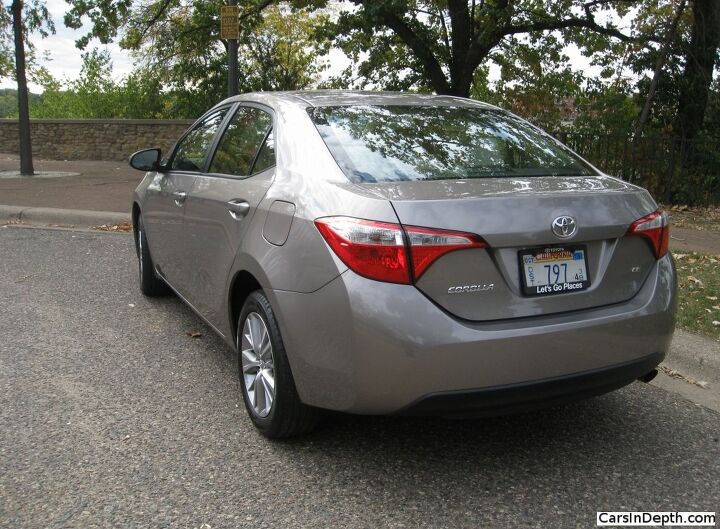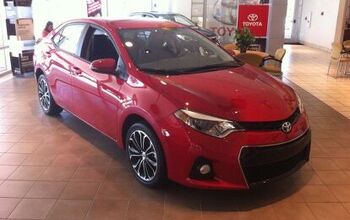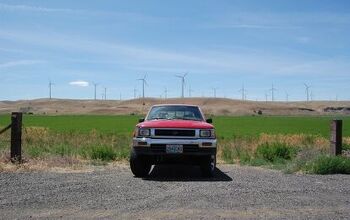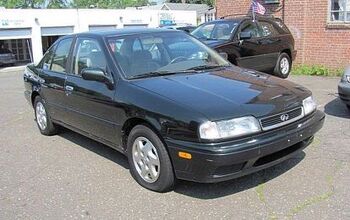Capsule Review: 2014 Toyota Corolla

Toyota may have become monumental on the basis of the midsize Camry’s popularity with American drivers over the past two decades, but that monument was built on the foundation of many, many compact Corollas. Before Lexus, before Camry, it was the Corolla that earned Toyota its reputation for reliability and quality construction. Forty million Corolla branded cars have been sold globally since the car’s introduction in 1968. For more than a generation, the conventional answer from both car enthusiasts and regular consumers alike, when asked to name a reliable small car, has been “Toyota Corolla”. Like Alfred Sloan proposed, Toyota knows that if you can capture car buyers when they are just entering the market, you can sell them a lot of cars over the course of their lives. While driving the latest Corolla isn’t on most car enthusiasts’ or automotive journalists’ bucket lists, the introduction of a new Corolla is indeed big news, at least as far as the car industry is concerned. Though the Honda Civic leads the segment in U.S. sales, the Corolla is close behind in second place and Toyota expects to sell about 300,000 Corollas this year. They’re hoping to increase that by 10% by selling cars to other than just traditional Corolla buyers, attracted by more exciting exterior styling and upgraded interior features.
The new 11th generation Corolla just recently started arriving at dealers and as part of the rollout, which includes an ad campaign that tries to be both nostalgic and contemporary, there was a media ride & drive event held in Minneapolis which included technical and marketing presentations. Toyota is a conservative company and those traditional Corolla buyers are equally conservative. As a matter of fact, the word “conservative” was mentioned unashamedly, a reference, no doubt, to the fact that the “new” Corolla is a derivative of the same basic platform that underlies the previous generation U.S. market Corolla. It may look all new on the inside and the outside, but the bones are still more or less the same. Conservative buyers may also explain why the Corolla that we get here in America has a beam rear axle setup, unlike the independent rear suspension featured on Toyota’s comparable European market car, the Auris (Europe’s Corolla is a cheaper car related to the Yaris). When I asked Paul Holdridge, vice president of sales for Toyota Division, Toyota Motor Sales, U.S.A, how come Europe gets IRS and we don’t, he said it had to do with differing driving styles, needs and expectations of American and European consumers.
The new Corolla doesn’t handle quite as well, even in S trim, as the Auris examples that I sampled last month (capsule review of the Auris hybrid soon come, mon, soon come), but I believe that Toyota’s product planners are correct, owners of previous Corollas and other potential Corolla buyers won’t notice, or care about, the kind of rear suspension the car has. Actually, the rear suspension has been upgraded with angled toe mounts that keep the rear axle located better under cornering forces. Other technical improvements in the Corolla lineup are six speed manual and automatic transmissions in the base L model, an in-house developed (with keiretsu associate Aisin’s help) CVT in the other models (you can get the S with the six speed manual as well), LED headlights on all models, a variable valve lift system called Valvematic in the LE Eco models, and Toyota has rebranded Entune to be the name for all of its center stack touchscreen based infotainment systems. The LE Eco is the first North American application of the Valvematic system. The 1.8 liter 2ZR-FAE engine in the Eco is rated at 140 HP and 126 lb-ft while the standard 2ZR-FE carried over from the previous Corolla is rated at 132/128. Other than the trick engine head, the two motors are identical. While in this application, variable valve lift is used to increase fuel economy, adding it to existing variable valve timing systems as the LE Eco does, has performance potential as well.
The rebranding of Entune is part of an overall upgrade of the Corolla’s interior. Even the base L model, which does not get an Entune branded system, comes with an audio system that is Bluetooth and smartphone capable. Toyota also no longer charges a subscription fee for Entune, instead making the Entune apps an extra cost option on the car. There’s still a lot of plastic in the Corolla interior, even hard plastic in some cases, but it never looks cheap and most touch points don’t feel cheap either. As mentioned, contrasting detail stitching, first seen on luxury cars, has now proliferated down to economy class. The new Corolla features both real and molded-in ersatz contrasting stitching. Ah, the democratization of luxury. The only part of the car that looked or felt cheap was the safety release on the hood latch, which worked fine but felt a little flimsy.
The LE Eco model uses Valvematic (which reduces pumping loses in the induction system at partial throttle), low rolling resistance tires, a rear spoiler and manipulation of the HVAC system to get a 42 MPG EPA rating. The Corolla lineup will include L, LE, LE Eco, and S models. The base car starts at $16,800 and a fully loaded S will run $22,300.
Toyota had Corollas with a variety of trim and equipment packages for us to sample on loops around the Twin Cities, along with a 2013 Corolla S for comparison (more on that later). Other than the Dodge Dart (which is sort of a larger, in-betweener segmentwise) I haven’t driven any of the other cars in the C segment, so I was able to judge the new Corolla on its own merits, and not whether or not it’s a class leader. Since I wanted to take the longer two routes (60 and 40 miles) so that I could get a more realistic appraisal of the cars I decided to drive only two cars, the one that enthusiasts would want to drive, the Corolla S with the six speed and a clutch, and the one that traditional Corolla buyers would get, a not quite loaded LE with the CVT. Toyota expects for the bulk of sales, 40% each, to go to the S and LE models, with the LE Eco and L models each taking up 10% of the mix.
The routes were a mix of winding 45-55 mph roads, with some slower 25 mph sections and a few Interstate miles as well. The weather was perfect, a warm early October day, sunny, and the scenery, with trees starting to change, and Lake Minnetonka and the Mississippi River along the routes, was lovely.
As I said, I can’t say that the new Corolla will be class leading, because I have little to compare it to. The cars were preproduction prototypes that I was told were identical, parts wise, with the cars now coming off the assembly lines in Mississippi and Ontario. All Corollas sold in North America are built here. There were no visible flaws, but then they were detailed to a fare thee well. The crew from the staging company even cleaned them up between drivers.
My assessment? The Corolla is an honest, competent car from a hypercompetent automaker. The S was almost fun to drive. With only 132 horsepower, it isn’t going to win any races (unless its a spec Corolla series), and if the steering of the Mazda3 is the standard by which steering feel is measured, the new Corolla is at the other end of the spectrum. Still, it goes where its pointed, there is relatively minimal body roll, and it has enough power that it can get out of its own way even if it only gets withing hailing distance of sporting. The LE is softer, with more body roll. Toyota tried to make the CVT act as much like a conventional automatic gearbox as they could, and for the most part they succeeded. There are seven imitation gear shifts that can be accessed manually in sport mode and they’re nice if you want the engine to rev out. I suspect, though, that most Corolla buyers won’t notice or even know what kind of automatic transmission they’re using. The only peculiarity with the CVT that I noticed was a bit of juddering in reverse. The six speed manual in the S was adequate. The throws aren’t particularly short and I missed a couple of shifts, though that could have been my fault. The clutch action was fine. I got right around 32 mpg with the S. The LE returned mileage that was much poorer, ~22 mpg according to the information screen, but I’m not convinced that I was using the info screen properly.
I like the new styling. It has a rounder, more organic shape based on the Corolla Furia concept shown at the NAIAS in Detroit last winter (or, more properly, the Furia concept was based on the new Corolla) and I’m guessing that Toyota’s California design studio had more to do with this car than the previous generation, which to my eyes looks like a Japanese design. Inside the new car is a pleasant space. One major change from the last Corolla is that the platform was stretched, yielding three more inches of legroom in the back. It felt spacious to me back there, but then I only have a 28″ inseam. The seats, both leather with cloth inserts on the S and all fabric on the LE, were comfortable, though I appreciated the firmer side bolsters on the S. There is a substantial false pedal on the left, if you’re the sort who braces when braking. Ergonomics are good and there are some thoughtful design touches like the way the arc of the cowl over the instrument panel echoes the curve of the steering wheel, and how the asymmetrical center stack visually curves around the wheel as well. Even with all those curves, Toyota designers were going for a linear, horizontal look with the dashboard so it has a spread out feel. The word “retro” was mentioned, which coincidentally is the word I used to describe the not entirely dissimilar Auris dash. According to the presentations, they were going for a more spacious feel to the cabin. The new Corolla is not as airy or as wide as the Dodge Dart but it’s not cramped.
Corolla Furia concept at the 2013 NAIAS in Detroit
Of course the improved interior includes the now ubiquitous contrasting detail stitching on the upholstery and there are luxury touches like piano black and flashes of color. There is a thin detail line that runs from door to door, across the dashboard. On the S that I drove it was blue, and on the LE it was a nice wood tone, which complemented the beige upholstery well. In the presentation they stressed the increased number of interior and exterior color choices. Perhaps we’re seeing an end to the “you can have any color interior you want as long as it’s a shade of grey” era.
The Entune systems in both cars easily paired to my Android phone and Steve Kimock’s various bands sounded just fine in both cars.
The Corolla is a very quiet, well composed car. It didn’t handle harsh, rough pavement as well as the Toyota Crown Royal did, but for a compact car the ride is admirable. It’s rather remarkable just how good economy cars are today. Brakes on the S were very good for normal driving conditions. They grabbed quickly and were easy to modulate. The brakes on the LE, which has drums in the back instead of the S’ four wheel discs, weren’t quite as good, but they won’t disappoint buyers.
In summation, that might be the Corolla’s biggest problem, trying to satisfy traditional Corolla buyers. There was nothing that I particularly disliked about the car. At the same time, there wasn’t much endearing about it either. The presence of the 2013 Corolla for comparison was telling. Toyota apparently benchmarked the new Corolla against the old one. There’s nothing wrong with not wanting to mess with success, but sometimes you can be a bit too conservative. Perhaps they should have benchmarked it against class leaders, it might have had more of a wow factor. Still, it’s a nice little car.
The new Corolla’s indeed a nice car and I can’t see that many of the 300,000 or so people who will buy the car every year will have buyer’s remorse. A friend of mine has a Camry from Toyota’s “fat product” period, the early 1990s, a ’93 I believe. That’s the car that crushed Detroit. In a number of ways, the 2014 Corolla is a nicer, more comfortable, better equipped car than that 20 year old Camry ever was. The problem for Toyota in growing Corolla sales is that it doesn’t matter to consumers if the 2014 is a better car than a 1993 Camry or even if it’s better than the 2013 Corolla. If they’re going to sell those additional 30,000 cars and challenge Honda for first place in the segment, the new Corolla will have to compare favorably to the Civic, the Ford Focus, the Hyundai Elantra and other cars in that class, not last year’s Corolla.
Toyota provided and lodging for this reviewer.
Ronnie Schreiber edits Cars In Depth, a realistic perspective on cars & car culture and the original 3D car site. If you found this post worthwhile, you can get a parallax view at Cars In Depth. If the 3D thing freaks you out, don’t worry, all the photo and video players in use at the site have mono options. Thanks for reading – RJS

Ronnie Schreiber edits Cars In Depth, the original 3D car site.
More by Ronnie Schreiber
Latest Car Reviews
Read moreLatest Product Reviews
Read moreRecent Comments
- Calrson Fan Jeff - Agree with what you said. I think currently an EV pick-up could work in a commercial/fleet application. As someone on this site stated, w/current tech. battery vehicles just do not scale well. EBFlex - No one wanted to hate the Cyber Truck more than me but I can't ignore all the new technology and innovative thinking that went into it. There is a lot I like about it. GM, Ford & Ram should incorporate some it's design cues into their ICE trucks.
- Michael S6 Very confusing if the move is permanent or temporary.
- Jrhurren Worked in Detroit 18 years, live 20 minutes away. Ren Cen is a gem, but a very terrible design inside. I’m surprised GM stuck it out as long as they did there.
- Carson D I thought that this was going to be a comparison of BFGoodrich's different truck tires.
- Tassos Jong-iL North Korea is saving pokemon cards and amibos to buy GM in 10 years, we hope.
































































































































Comments
Join the conversation
Europeans like the dual clutch trannys, they usually are ahead of even California.
If you can't objectively review a Toyota product (you admitted it), why don't you just be honest with yourself and everyone else and don't?